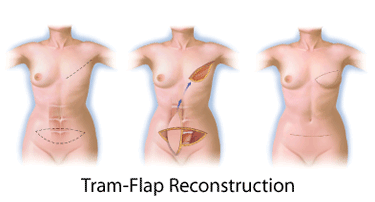Your Options for Breast Reconstruction in Northern Virginia
Breast reconstruction is a surgical procedure designed to restore the size, shape and appearance of the breast after a mastectomy (removal of the breast due to cancer). The decision to undergo reconstructive surgery is extremely personal and there are many techniques designed to meet the individual goals and physical needs of each patient.
Ideally, breast reconstruction is discussed with your breast surgeon and Dr. Hess and planned prior to the mastectomy. The best time to undergo reconstructive breast surgery is at the same time as the mastectomy. At that time, the chest wall is normal and undamaged from radiation or scarring.
However, some patients can’t consider reconstruction at the same time as the mastectomy for various personal and emotional reasons. In addition, if radiation in the chest is needed post-mastectomy, it is usually advised to delay reconstruction until after radiation treatment is completed.

Dr. Hess with breast reconstruction patient Pam.
Breast Reconstruction: A Patient’s Journey
A breast reconstruction patient who also happens to be a talented writer has kindly agreed to publish excerpts from her personal journals on our website, in an effort to share her experience with other breast cancer patients who are in the midst of a difficult and painful journey.
Both Pamela and Dr. Hess have contributed their unique perspectives on the experience.
Breast Reconstruction Procedures
One of the most rewarding procedures that we perform at Hess Plastic Surgery is the reconstruction of a breast that has been removed due to cancer or other disease. New medical techniques and devices have made it possible to create a natural-looking breast that is similar in shape and appearance to an existing breast.
Wonderful results can be achieved in this area and we can help you understand your options and talk through the different ways of recreating the breast.
There are three general options for breast reconstruction. One method is to use a breast implant, the second is to use your own tissue, and the third combines both an implant and your own tissue. There are pros and cons to each method; the American Cancer Society provides a good overview of these pros and cons, based on studies of actual patient outcomes. Dr. Hess will discuss the options available to you and help you make a decision appropriate for your needs.
Using Breast Implants for Breast Reconstruction
A saline or silicone gel implant is used to mold a new breast shape. If your skin and chest wall tissues are tight and flat, this may be done in multiple stages, wherein a tissue expander is placed beneath the skin and chest muscle. This expander is filled with saline, which creates a new cavity over time. Once the cavity reaches the correct size, the tissue expander is replaced with a standard implant.
Most patients who choose to have a breast implant reconstruction undergo this sequence of procedures. Some patients may be candidates for immediate implant placement after mastectomy. Dr. Hess will discuss your mastectomy procedure in detail with your breast surgeon and determine if you may be a candidate. Undergoing reconstruction with breast implants should not interfere with future mammograms and can be an excellent option for women to achieve very natural-looking, symmetrical breasts.
Autologous Tissue Flap Breast Reconstruction
Dr. Christopher Hess is skilled in using both the latissimus dorsi techniques and the TRAM flap procedure in reconstructing the breast.
The basic idea of a tissue flap is to take your own skin, fat, and sometimes muscle from one area of the body and use them to reconstruct a new breast. Studies show that patients who choose natural tissue breast reconstruction have higher satisfaction rates overall (¹,²,³) but somewhat higher complication rates as well. Dr. Hess will discuss the pros and cons with you to help you make an informed decision.
TRAM Flap
A TRAM (transverse rectus abdominis muscle) flap uses the lower abdomen, between the waist and pubic bone as a donor site. In terms of the tissue removed, the TRAM flap procedure is very similar to a tummy tuck. There is typically enough skin, fat, and blood vessels to reconstruct a breast. One abdominal rectus muscle (one side of the “six-pack”) must be removed, however, to form the base of the breast mound.

Latissimus Dorsi Flap
A latissimus dorsi flap uses the upper back as the donor site. The latissimus dorsi muscle from the back is tunneled under the skin to the front of the chest. This creates a convenient pocket that can be filled with an implant to add fullness to the reconstructed breast. The donor site incision is easily hidden when wearing a backless dress.
Nipple Reconstruction
Nipple and areola reconstruction is an optional secondary surgery following breast reconstruction. If necessary, nipple and areola reconstruction will be done three to four months following breast reconstruction to allow time for healing. Like the tissue flaps, donor skin from your body is typically used to reconstruct the nipple and areola.
The areola is tattooed using permanent makeup to make it look very similar to the original areola. This last step is very crucial and completes the sequence of breast reconstruction.
How long is the recovery after breast reconstruction?
Recovery time will vary depending on the procedure you choose. With implants, you are likely to feel fatigue and soreness for one to two weeks after your breast reconstruction. If you choose a tissue flap, recovery typically takes longer. Most candidates can completely return to normal activities in as little as three to four weeks with an implant, or six to eight weeks after a tissue flap procedure.
It is normal to have decreased sensation around the breast after your operation. Some of this numbness may resolve with time. Due to various factors like tissue swelling, your new breast tissue may not completely heal for up to a year. Scars will start out as pink or red, but will certainly fade with time.
Make an Appointment with Dr. Hess
If you are ready to discuss your options for breast reconstruction, contact us at Hess Plastic Surgery to schedule a personal consultation with Dr. Hess. He will listen to your concerns, answer your questions about reconstructive breast surgery, and help you take the next steps as a breast cancer survivor.

